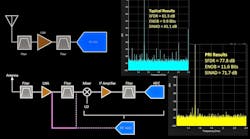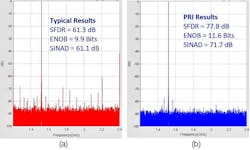What you'll learn:
- The integral role of software-defined radios in today's RF design.
- Why is an analog-to-digital converter such a key factor in SDRs?
- How to minimize SFDR to maximize ADC performance with a novel technique.
Of the most important technological advances in receiver technology over the last 20 years, two stand out: software-defined radio (SDR) and direct RF sampling. The SDR has almost completely redefined how transceivers are designed and constructed, allowing manufacturers to use a common hardware platform to serve multiple product lines by reconfiguring it in software even after being deployed, without hardware changes.
In one important way, direct RF sampling has made the SDR possible, as it digitizes the analog input signal as near as possible to where it enters the receiver. This achievement is realized by the analog-to-digital converter (ADC), whose performance affects how well the entire receiver will perform. However, neither the ADC, nor optimizing it, are simple, so it’s important to understand how to tame some of its more undesirable side effects.
In a traditional heterodyne architecture (Fig. 1), after the receiver picks up the signal at RF frequencies, it downconverts it to a lower intermediate frequency (IF), where it’s digitized, filtered, and demodulated. In contrast, a direct RF-sampling receiver (Fig. 2) consists of only a low-noise amplifier, a bandpass filter, an anti-aliasing filter, and an ADC. It eliminates the need for mixers and local oscillators because it digitizes the RF signal directly, eliminating many analog components and their inherent nonlinearities.
The Importance of the ADC
In any receiver, high performance can only be obtained when its signal-to-noise ratio (SNR) and spurious-free dynamic range (SFDR) are very high, both being attributes directly related to the ADC. So, for designers, the goal is to optimize ADC performance, in part by mitigating its negative characteristics.
While the ADC’s sampling rate, bandwidth, SNR, and effective number of bits (ENOB) all play key roles, SFDR is perhaps the most important metric. SFDR, defined as the ratio between the fundamental tone and the largest harmonically or non-harmonically related spur in the bandwidth of interest, effectively determines the usable dynamic range of a receiver.
Unfortunately, an ADC introduces quantization, offset, gain, linearity, and timing errors that create spurious signals in its output that have a negative effect on SFDR. These signals can interfere with signals of interest, compromising their data and causing, among other things, high bit-error rates and distortion to the point where the desired signals are compromised or hidden by the spurs and go undetected.
Unlike the desired signal, spurs aren’t affected by analog filters earlier in the signal path; rather, they can appear at any frequency in the ADC sample’s frequency range. They can also occur at frequencies well beyond the ADC sampling frequency and then be aliased down to frequencies below the sampling frequency.
Various types of compensation have been developed to address these errors, but they make only modest improvements to SFDR while having other drawbacks. For example, adding a dither signal adds noise at a level greater than the nominal quantization-step size. However, out-of-band noise dithering reduces the dynamic range of the ADC and increases phase noise. Commutating the ADC at lower rates introduces interleaving spurs, another source of errors.
What about ADC calibration as a remedy? Unfortunately, an ADC is extremely sensitive to temperature, limiting its use to stable temperature environments. This is problematic in an aircraft or even many industrial environments, where wide temperature swings require calibration to be performed in real-time. In addition, all of these techniques become increasingly ineffective at higher frequencies. In short, these and other measures are either complicated, unreliable, require considerable processing resources, or aren’t particularly effective.
A Different Approach
The latest technology created to tackle the ADC dilemma is dubbed the High Dynamic Range Receiver (HDRR), created by Precision Receivers. It delivers an increase in SFDR of up to 16 dB by reducing ADC-induced spurious signals to levels previously unachievable (Fig. 3). Shrinking these signals and the higher SFDR obtained by HDRR allows signals that would otherwise be obscured to be revealed to the receiver. This, in turn, makes it possible to identify and analyze much weaker signals of interest.
HDRR uses an advanced clocking and sampling approach that mitigates the spurs and the resulting intermodulation distortion while also preserving the signal’s original phase and amplitude as measured at the antenna. It can be used in any receiver regardless of its ADC manufacturer, at any frequency of interest, without the need for calibration, while reducing analog components and the complexity of anti-aliasing filters.
Because HDRR doesn’t introduce dithering and there’s no added phase distortion, it can easily deliver a time- or frequency-domain series at user-specified, low-latency update intervals. To achieve its results, HDRR uses information available from the analog-to-digital conversion process that’s encoded in the HDRR clocking method. After the process is completed, the clocking information can be applied to segregate Nyquist information from multiple zones, which keeps the desired frequencies in-band and rejects the out-of-band frequencies.
Subsequently, the receiver is able to determine each signal’s Nyquist zone location and extract additional information from it. HDRR can also tune in any Nyquist zones presented to the input or simultaneously tune in all Nyquist zones. This enables systems to monitor broad bandwidths while also reducing the complexity of anti-aliasing filters or even eliminating them in low signal-density environments.
The process is performed by digitally isolating one Nyquist zone from another. Thus, the amplitude and phase of frequencies within one Nyquist zone can be distinguished from those in other Nyquist zones, with the result being precise signal representation.
In some applications, the goal is to obtain information within frequencies of interest; in others, it’s to examine the rejection of aliased frequencies folding over the Nyquist rate. These aliased frequencies may not be entirely removed by analog filtering and possibly leak into an adjacent Nyquist zone. The “Nyquist tuning” process rejects these leaked signals, revealing signals of interest, free of the phase distortion caused by analog filtering.
Nyquist tuning also allows for the calculation of multiple Nyquist zones simultaneously without using multiple stitched receivers, avoiding the phase and amplitude distortion caused by stitching the different frequency bands together. This is accomplished because the specific Nyquist zone number is a parameter in the Nyquist tuning calculation and is independent of the HDRR signal-acquisition process.
Additional information available from the analog-to-digital conversion process is used within HDRR’s encoded clocking method. After the process is completed, the clocking information can be used to separate the different pieces of Nyquist zone information, which is helpful to keep the right frequencies in-band and reject the out-of-band frequencies.
Benefits in Specific Applications
Although the improvements produced by HDRR are essentially the same regardless of the receiver, every application reaps different benefits. For example, in an electronic-warfare system, the time from signal capture to matching signals with those in threat libraries is reduced because of higher signal fidelity. It also allows sampling to be performed over broader instantaneous bandwidths, increasing the detection range.
In an active electronically scanned array (AESA) radar, HDRR increases detection range, improves observation of targets with very low radar cross-sections, removes false targets, and reduces the false-alarm rate. In addition, HDRR rejects signal aliasing, fold-over ghost images, and reflections. And in both applications, a spectrum free of spurious signals equates to increased signal-to-noise ratio and SFDR.
Spectrum monitoring in densely packed frequencies requires receivers that provide a clear view of the spectral environment over enormous bandwidths. Even wireless communications systems can benefit because spurious signals reduce dynamic range and limit coverage and capacity. As 5G deployment expands, thousands of small cells will be operating in proximity, which increases the need for clean signal environments. By reducing spurs and boosting SFDR, HDRR can trim down the number of cells required in each area, lowering deployment costs while increasing the quality of service.
Other applications include medical imaging, in which the ability to strip these damaging signals away results in more accurate representations. Finally, receivers are as sensitive to spurious signals as those used for radio astronomy. HDRR enables large, fast bursts of RF energy (Askaryan radiation) to be detected over broad bandwidths and allows for wide-sky, wide-bandwidth signal acquisition through methanol (CH3OH) spectral lines.
Summary
In the coming years, the SDR will become the receiver architecture of choice in nearly all types of systems, including those discussed in this article, and the ADC will be one of the most important drivers of its success. As the sampling rate and instantaneous bandwidth of ADCs continue to increase, it will be possible to directly sample signals at higher frequencies. To ensure these devices are free of spurious emissions, techniques such as HDRR will be required well into the millimeter-wave region.



